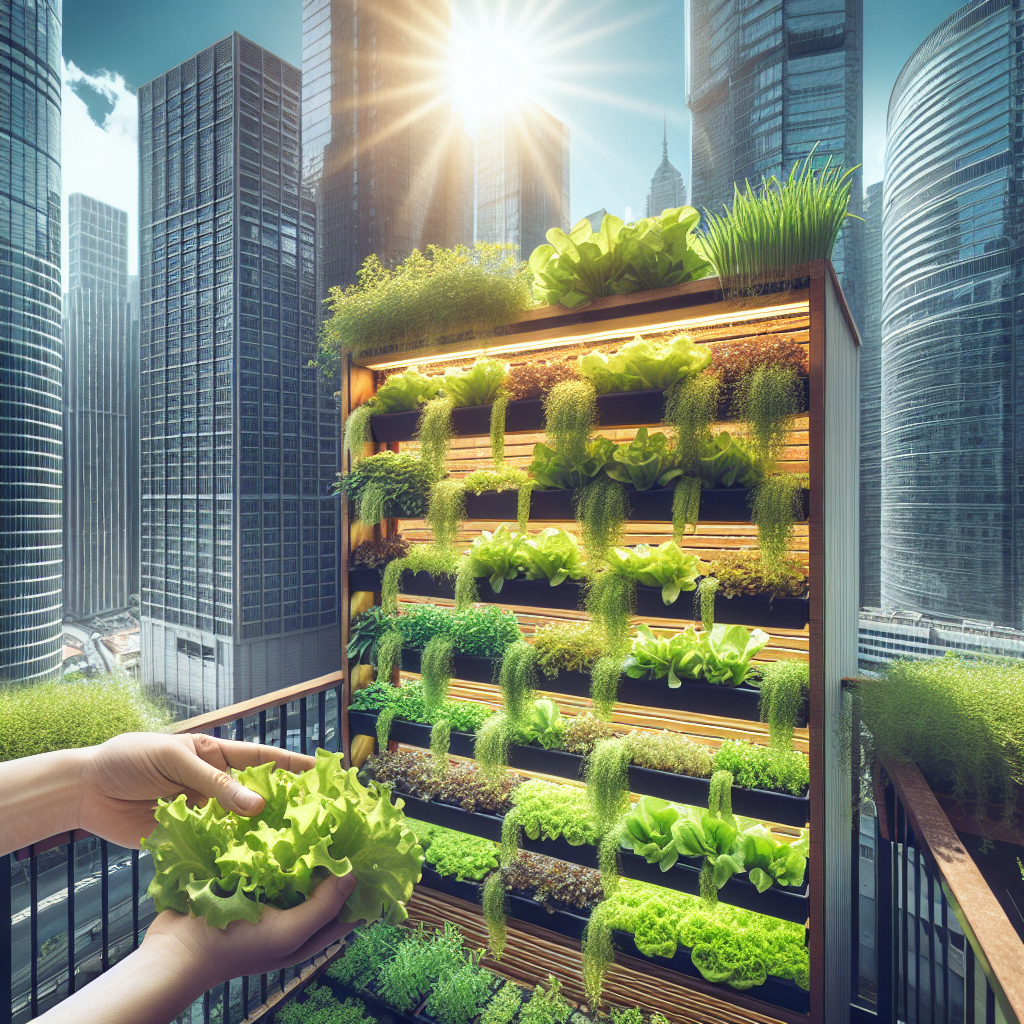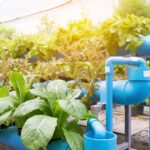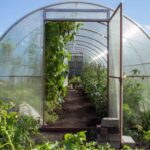
Unlock the Secrets of Urban Green Thumbs
Imagine a lush oasis of fresh salad greens, right in your urban dwelling. It’s not just a dream; it’s a reality that’s within your reach. Growing organic salad greens in confined spaces is not only possible, but it’s also incredibly rewarding. You don’t need acres of land or a green thumb passed down through generations. All you need is the right approach, a little bit of know-how, and the passion to see it through.
Article-at-a-Glance: Your Blueprint for Lush Salads in Small Spaces
- Discover the best salad greens to grow in limited urban spaces.
- Learn how to optimize light and shade to boost your greens’ growth.
- Understand the essentials of soil and compost for healthy plants.
- Explore creative container and vertical gardening solutions.
- Get equipped with organic methods to protect your greens from pests.
Choosing Your Green Companions
Not all salad greens are created equal, especially when it comes to growing them in confined urban spaces. Some thrive in the cozy corners of your balcony, while others prefer the sprawling expanse of a community garden plot. But fear not, I’ll guide you to the varieties that are not just willing, but eager, to grow in the unique conditions your urban space offers.
Best Varieties for Tight Quarters
When space is at a premium, your choice of greens becomes crucial. Lettuce, with its compact growth habit, is a natural fit for small spaces. Varieties like ‘Little Gem’ or ‘Tom Thumb’ are particularly well-suited for containers. Arugula, with its peppery flavor, grows quickly and doesn’t need much room to flourish. Spinach, a nutrient powerhouse, is also a great option as it can be harvested leaf by leaf, allowing the plant to continue growing.
Understanding Light and Shade for Optimal Growth
Light is the lifeblood of plants, but in the urban jungle, it’s a resource that’s often in short supply. The good news is that many salad greens are tolerant of partial shade. However, to really thrive, they’ll need at least 3-4 hours of sunlight a day. If your space doesn’t get enough natural light, consider a grow light. It’s an investment that can turn a dim corner into a productive mini-farm.
Setting the Stage for Success
Before you sow a single seed, it’s essential to prepare the stage. The right foundation can make the difference between a thriving garden and a struggling one. This means choosing the right soil, understanding the watering needs of your plants, and selecting the best containers for your space. Let’s set the stage together, ensuring your urban garden is a resounding success from the start.
Soil and Compost: The Foundation of Your Urban Eden
Healthy plants start with healthy soil. It’s the secret sauce, the bedrock of your garden’s ecosystem. In urban settings, the quality of the soil in your containers is even more critical because your greens can’t spread their roots in search of nutrients. Opt for organic potting mix that’s rich in compost to give your plants a balanced diet. Remember, compost is like a slow-release superfood for your plants—it improves soil structure, retains moisture, and provides a steady stream of nutrients.
Water Wisdom: Keeping Thirst at Bay
Water is a precious commodity, especially in the city. Your salad greens need consistent moisture to thrive, but not so much that their roots become waterlogged. The key is to water deeply but infrequently, encouraging strong root growth. Keep an eye on the weather and your plants, and adjust your watering schedule accordingly. A simple finger test—plunging it into the soil—can tell you if your plants are thirsty. If the soil is dry an inch below the surface, it’s time to water.
Containers and Vertical Solutions
When horizontal space is scarce, look up! Vertical gardening and container solutions are your allies in the urban jungle. They allow you to maximize your growing area by taking advantage of vertical spaces like walls, railings, and even ceilings. With a bit of creativity and some basic supplies, you can transform your balcony or window into a vertical farm that’s not only productive but also aesthetically pleasing.
Thinking Outside the Box: Creative Container Ideas
Containers are the building blocks of urban gardening. But who says they have to be boring? Think beyond traditional pots and explore other options like fabric grow bags, repurposed buckets, or even hanging shoe organizers. Each type of container has its own benefits, from promoting air pruning in fabric pots to making use of vertical space with hanging options. Choose containers that fit your space and style, and make sure they have proper drainage to keep your greens happy.
Making the Most of Vertical Space
Vertical gardening is like a game of Tetris with plants. Use stackable planters, trellises, or even upcycled pallets to create layers of greenery. Not only does vertical gardening save space, but it also can help protect your greens from some ground-dwelling pests. Plus, it makes for a stunning visual display. Climbing varieties like peas can be trained up a trellis, while hanging baskets can showcase trailing herbs like thyme and oregano.
The Dynamics of Space Efficiency
Efficient use of space is the name of the game in urban gardening. Every square inch counts, so think about how you can get the most out of your growing area. This might mean planting in succession—starting a new crop as soon as one is harvested—or intercropping, where you grow smaller plants in the spaces between larger ones. It’s all about creating a harmonious ecosystem where each plant supports the growth of others, maximizing your yield without needing more space.
Intercropping: Maximize Yield in Minimal Area
Intercropping is a smart strategy to get the most out of every inch of soil. It involves planting different crops close together in a way that they benefit from each other. For example, planting fast-growing radishes alongside slower-growing carrots can maximize your space efficiency. The radishes will be ready to harvest just as the carrots need more room to grow. This method not only saves space but also can help deter pests and diseases, as the diversity of plants creates a more resilient ecosystem.
Pruning and Training for Space Management
Pruning isn’t just for ornamental plants—it’s a useful tool for managing your edible greens, too. By selectively removing parts of the plant, you can control its shape and size, ensuring it doesn’t overstep its bounds in your limited space. Training plants to grow in certain directions with supports or ties can also help you make the most of the area you have. For example, guiding a tomato plant to grow upwards rather than outwards can free up precious horizontal space for other greens.
The Battle Against Pests and Diseases
Even the most carefully tended urban garden can fall prey to pests and diseases. But don’t let that discourage you. With a few clever strategies and a watchful eye, you can keep your greens healthy and thriving. Remember, the best defense is a good offense, so let’s focus on creating an environment that’s more hospitable for your plants than for pests and pathogens.
Organic Pest Control Tricks
Organic pest control is all about working with nature, not against it. Introduce beneficial insects like ladybugs or lacewings to keep aphid populations in check. Use barriers like floating row covers to protect your greens from munching caterpillars and beetles. And don’t forget about the power of plants—companion planting with herbs like basil or marigolds can help repel unwanted insects. These tricks keep your garden chemical-free and your salad greens safe to eat straight off the plant.
Preventing Common Diseases in Salad Greens
Diseases can be a challenge, but they’re not inevitable. Good garden hygiene is key—remove any diseased leaves promptly to prevent the spread of pathogens. Ensure your plants have adequate airflow by not overcrowding them and using proper pruning techniques. Water at the base of the plants to keep the foliage dry and less prone to fungal diseases. And rotate your crops, so you’re not planting the same family of greens in the same spot each season, which can build up disease pressure.
The Harvest Hub
Harvest time is the most rewarding part of growing your own salad greens. To ensure you’re picking your greens at their peak, keep an eye on their growth and harvest in the cool of the morning when their leaves are most crisp. Cut-and-come-again varieties can be snipped a few leaves at a time, providing a continuous yield. And when it’s time to store your bounty, remember that most salad greens prefer a cool, humid environment. A salad spinner can help remove excess water, and a breathable bag in the fridge can keep them fresh for days.
Timing Your Harvest for Peak Freshness
Picking your salad greens at just the right moment is crucial for the best flavor and nutrition. Most greens are at their prime early in the morning, after the dew has settled. This is when they’re most hydrated and crisp. For leafy greens like lettuce and spinach, harvest when the leaves are tender and full-sized but before they reach maturity. This prevents them from becoming bitter and tough. If you’re growing cut-and-come-again varieties, snip the outer leaves first, allowing the inner ones to continue growing. Timing is everything, and with a little practice, you’ll be a pro at harvesting your greens at their peak.
From Garden to Plate: Storing and Enjoying Your Greens
Once you’ve harvested your greens, the clock starts ticking. To preserve their freshness, wash them gently, pat dry, or use a salad spinner to remove excess moisture. Store them in a breathable bag or container in the crisper drawer of your fridge. They’ll stay fresh for about a week, sometimes longer if they’re really fresh. But remember, the sooner you eat them, the better they’ll taste and the more nutrients they’ll provide. So, plan to enjoy your homegrown salads often, reveling in the flavor that only comes from greens you’ve grown yourself.
Frequently Asked Questions
How do I manage pest control in a small space?
- Inspect plants regularly for early signs of pests.
- Use natural predators like ladybugs to control aphids.
- Employ barriers such as row covers to protect plants.
- Introduce companion planting to deter pests naturally.
- Opt for organic insecticidal soaps or neem oil as a last resort.
- Maintain cleanliness and remove any infested plants promptly.
Managing pests in a small space requires vigilance and a proactive approach. By creating an environment that’s less attractive to pests and more conducive to plant health, you can minimize the need for interventions. And when you do need to take action, there are plenty of organic options that won’t harm your plants or the environment.
What are some fast-growing salad greens suitable for an urban environment?
- Arugula – Peppery and fast, ready in as little as 4 weeks.
- Spinach – Versatile and vitamin-rich, harvestable in 4-6 weeks.
- Mustard Greens – Spicy and speedy, ready in 3-5 weeks.
- Baby Kale – Tender and quick, ready in 5-7 weeks.
- Mizuna – Mild and resilient, ready in about 4 weeks.
- Leaf Lettuce – Comes in many varieties, ready in 4-8 weeks.
Urban environments are perfect for growing a variety of fast-growing salad greens. These greens don’t need much room and can be harvested at a young stage, which means you’ll be enjoying fresh salads in no time. Plus, their quick turnaround makes them ideal for succession planting, ensuring a continuous supply of fresh greens.
Can salad greens grow indoors year-round?
- Yes, with sufficient light from a sunny window or grow lights.
- Choose varieties that are known for their tolerance to indoor conditions.
- Maintain a consistent indoor temperature and humidity level.
- Use quality potting mix and ensure proper drainage.
- Be mindful of watering and fertilizing, as indoor conditions can affect these needs.
Salad greens can indeed be grown indoors throughout the year, providing a constant supply of fresh foliage. With the right conditions—adequate light, temperature control, and proper care—your indoor garden can be just as productive as one outdoors. This means you can enjoy homegrown salads even when it’s snowing outside!
How often should I water my organic salad greens?
Watering your organic salad greens is more of an art than a strict schedule. The frequency depends on several factors, including the type of greens, the stage of growth, the weather, and the type of container you’re using. A good rule of thumb is to check the soil moisture every day. If the top inch of soil feels dry to the touch, it’s time to water. During hot, dry periods, your greens may need water daily. In cooler weather or if your containers are in the shade, they might only need water every few days.
- Check soil moisture regularly—daily in hot weather, less often in cool weather.
- Water deeply to encourage deep root growth, which helps plants withstand drought.
- Use a watering can with a rose attachment to mimic gentle rain and avoid disturbing the soil or damaging tender leaves.
- Consider self-watering containers or a drip irrigation system for consistent moisture and less frequent watering.
- Always water in the morning to reduce evaporation and allow leaves to dry, which helps prevent disease.
Consistency is key. Keeping the soil evenly moist, not waterlogged or bone dry, will lead to lush, tender greens. Remember, your plants will tell you what they need—if the leaves look wilted or the growth seems stunted, it’s likely time to give them a drink.
What is intercropping, and how can it help me grow more in less space?
Intercropping is a savvy gardening technique where you grow two or more crops together in the same space. The idea is that different plants have different needs and growth patterns, so you can maximize your limited space by pairing them smartly. For example, you might plant tall, sun-loving tomatoes alongside low-growing, shade-tolerant lettuce. The lettuce benefits from the shade provided by the tomatoes, and you get two crops from one patch of soil.
- Combine plants with different heights, root depths, and nutrient needs to make full use of space and resources.
- Grow quick-harvest crops like radishes between slower-growing vegetables like broccoli.
- Plant nitrogen-fixing legumes near nitrogen-hungry leafy greens to naturally enrich the soil.
- Use intercropping to confuse pests and reduce the spread of diseases.
- Harvest the ‘intercrop’ before it competes with the main crop for light and nutrients.
Intercropping not only maximizes space but also promotes a healthier garden ecosystem. It’s a dynamic way to get more from your garden without needing more room. Plus, it’s a natural method to manage pests and improve soil health—win-win!
As you embark on this journey of growing organic salad greens in confined urban spaces, remember that each small step you take is a leap towards a greener, healthier lifestyle. You’re not just growing food; you’re nurturing your connection to nature, right in the heart of the city. The tips and techniques shared here are your tools to transform even the smallest spaces into verdant, productive gardens. So, roll up your sleeves and let’s turn those concrete jungles into edible ones, one pot of salad greens at a time.
Embrace the joy of harvesting your own crisp, flavorful greens, knowing that you’ve nurtured them from seed to salad bowl. Share the bounty with friends and neighbors, and spread the word that urban agriculture is not just a trend—it’s a sustainable way of living that enriches our lives and our communities.
Keep experimenting, keep learning, and keep growing. The urban garden you cultivate today will sow the seeds for a greener tomorrow. Happy gardening!






